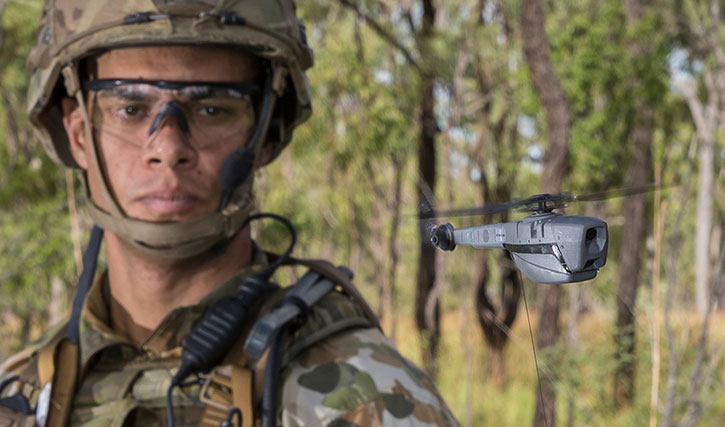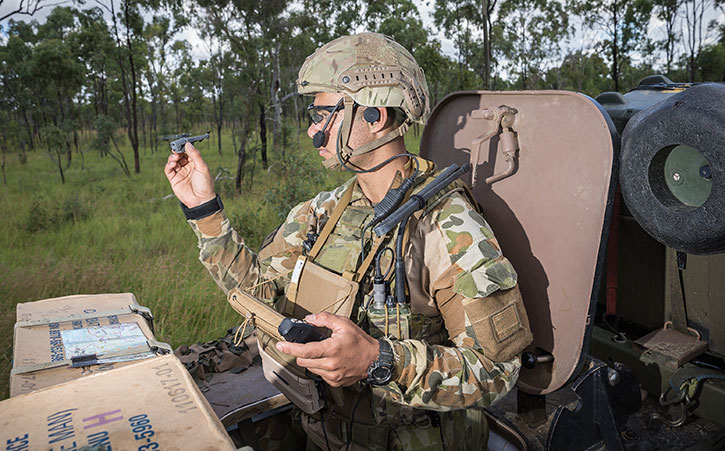
Since the acquisition of the Norwegian Prox Dynamics company in 2016 FLIR Systems scored several important sales of Prox’s Black Horner PD-100 Personal Reconnaissance System (PRS). Over the years the companies delivered over 5,000 PRS units to 20 customers worldwide, mostly counter-terrorist and special weapons and techniques (SWAT) teams and special forces. At present FLIR continues to manufacture the PRS in Norway.
So far, the regular military was not too receptive to the miniature drone, considering it too delicate and expensive for field operation by non-specialists. But this perception is changing. In the recent months, the Black Hornet has been fielded with two new customers – the Australian and Dutch armies, while an enhanced system – Black Hornet III is undergoing testing with the US Army and Marine Corps, toward an acquisition of dozens of systems by the U.S. Army, for fielding with an entire infantry brigade.
The PD-100 was first deployed by the Norwegian and British forces in 2013, when Prox received their first orders, under an urgent operational requirement (UOR) worth £25 million. At the time the Brits wanted to improve situational awareness for their troops in Afghanistan and the PRS was called to provide remote surveillance to improve force protection and counterinsurgency. Upon their return to their homeland, in 2015 the Black Hornet program was discontinued.
More recently, other countries began evaluating these nano drones as personal surveillance capability organic to infantry squads and platoons. The Australians pioneered this approach, deploying a large number of drones for testing with troops. Following extensive evaluation, the Australian Defense allocated A$18 million by the end of 2017 to field the flying sensors as an organic surveillance and reconnaissance supporting the combat brigades at the platoon and troop level.

“UAS are a game-changer for the Army, providing enhanced situational awareness for better mission execution for Australian soldiers,” Commander 6th Brigade, Brigadier Susan Coyle said. Currently, the 6th Brigade operates the Australian Army’s only UAS unit – the 20th Surveillance Target Acquisition Regiment. By the end of the year, the PRS will be deployed with the 7th Combat Brigade down to Platoon level, becoming the first Army fielding such capabilities with the regular force. Deploying with every squad in the brigade’s reconnaissance units. “The Australian Army is now the biggest user of Nano UAS in the world. It is also the first in the world to proliferate this technology to the conventional forces down to combat platoon level,” Brigadier Coyle said.
The US Army also plans to deploy the PRS at the squad level. Although the acquisition of 61 Black Hornet III small unmanned aerial systems was approved this year, the U.S. Army plans to evaluate other soldier borne sensors from different vendors in October 2018 by the by Soldiers from 7th Infantry Division.
At a weight of 1.3 kg, the nano-UAS system packs two Black Hornet flying sensors stored in a docking station that also includes the display console, batteries, charger and the communications terminal. Weighing only 18 grams, each miniature helicopter can fly for 20-25 minutes, at a speed of 18 km/h, out to a distance of 1,500 meters (line of sight) from the user. Preparation to flight is intuitive and takes about 60 seconds. Two cameras The miniature helicopter operates two cameras, one taking live video and the other shooting stills. Images and live video are streamed simultaneously, to the user’s monitor, over an encrypted data link. The system is also equipped with thermal imaging, which gives it night vision capability.
Similar to the modern miniature multirotors, at such a low weight the nano-drone is vulnerable to wind conditions although it can withstand gusts below 12 m/s. The Black Hornet III variant developed for the US Army employs a dedicated, encrypted datalink and includes three nano drones, enabling users to extend the missions to 2.5 hours (150 minutes).
The Black Hornet is not designed for long-term surveillance. Each system comprises two micro UAVs, (the U.S. bound Black Hornet III carries three) to sustain continuous operation for 2.5 hours, since, as one Black Hornet is aloft, another battery can be charged and ready when it returns. Although the operation of the system is intuitive, it takes about 16 hours to fully train a soldier to pilot, use and maintain the system and achieve effective operational use said According to Capt. WaiWah Ellison, the assistant program manager for Soldier Borne Sensors, at the US Army PEO Soldier.
According to information released by FLIR Systems, the Black Hornet III helicopter weighs 32 grams, slightly more than previous models. It offers several improvements over previous versions, such as improved speed and distance, with the ability to fly two kilometers at speeds of over 21 km/h. Its sensors support sharper imaging processing, featuring the FLIR Lepton thermal microcamera core and a visible sensor, allowing greater image fidelity. An improved encrypted military-approved digital datalink supports beyond line-of-sight (BLOS) and operations indoors. The system supports the military standard ‘Android Tactical Assault Kit’ (ATAK), to interface with battlefield networks and distribute information to anyone on the network.
The nano helicopter flies autonomously to follow waypoints marked by the user on an aerial map, or controlled manually using an intuitive handle that comes with the kit. The system has a low acoustic signature and is virtually inaudible even from a short distance. At such a low weight it is inherently safe to fly near people, therefore, it can operate almost anywhere at any time without prior airspace coordination. As these miniature aerial vehicles have a minimally audible signature and visual profile, they are virtually undetectable, even from extremely short distances.





















